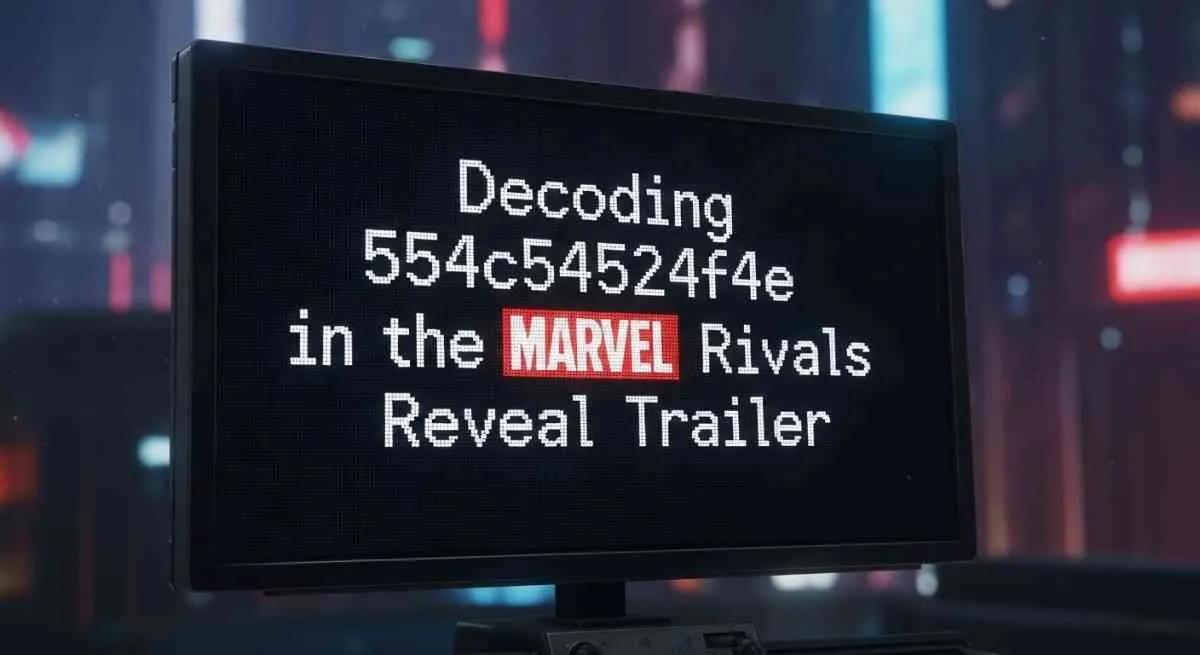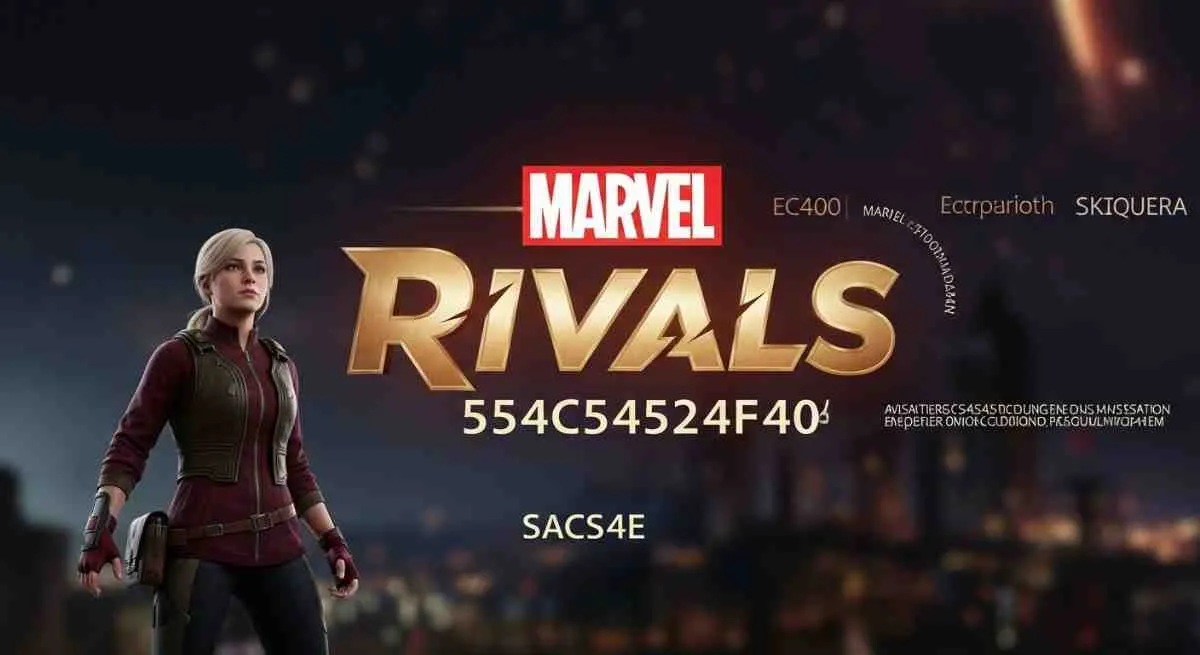When Marvel Rivals dropped its character reveal trailer, eagle-eyed fans quickly spotted something peculiar: a cryptic alphanumeric sequence that appeared to be more than just random characters. The mysterious code “554c54524f4e” sparked intense debate across gaming communities, with passionate fans diving deep into theories about its meaning. What seemed like an obscure string of letters and numbers turned out to be one of the most clever Easter eggs in recent gaming history—a hidden message that perfectly encapsulated the mechanical terror that is Ultron.
In this comprehensive guide, we’ll walk you through everything you need to know about this fascinating code, from the technical process of decoding hexadecimal to ASCII conversion, to the community reaction that helped crack this digital puzzle. Whether you’re a seasoned programmer or simply curious about how these hidden messages work, you’ll discover the brilliant simplicity behind this seemingly complex code.
What Is 554c54524f4e? The Hidden Code Explained
Ultron’s in-game signature, 554C54524F4E, is his name written in ASCII hexadecimal code. This sequence appeared prominently in Marvel Rivals promotional materials, serving as both a character signature and an ingenious marketing tool that engaged the community in active participation.
The code represents a hexadecimal encoding system, where each pair of characters corresponds to a specific ASCII value. In computing, hexadecimal (base-16) is commonly used to represent binary data in a more human-readable format. What makes this particular implementation brilliant is how it transforms Ultron’s identity into the very language he would naturally speak—machine code.
Marvel Rivals developers strategically placed this code in trailer footage, character reveal materials, and promotional content, knowing that dedicated fans would eventually crack the puzzle. The choice to use hexadecimal encoding aligns perfectly with Ultron’s character as an artificial intelligence, creating a thematic connection between the character’s digital nature and the marketing approach.
This type of coded messaging has become increasingly popular in gaming marketing, where developers embed hidden clues that reward attentive fans with exclusive insights or early reveals. The 554c54524f4e code exemplifies this trend, creating a sense of discovery and community engagement that traditional marketing methods often struggle to achieve.
How to Decode 554c54524f4e Hexadecimal to ASCII
Understanding how to decode hexadecimal to ASCII opens up a world of hidden messages in digital media. The process involves converting each pair of hexadecimal digits into their corresponding ASCII character values. Here’s a step-by-step breakdown of how to tackle this conversion:
Step-by-Step Conversion Process
First, divide the hexadecimal string into pairs: 55, 4c, 54, 52, 4f, 4e. Each pair represents one ASCII character in hexadecimal format. Next, convert each hexadecimal pair to its decimal equivalent, then reference the ASCII table to find the corresponding character.
For manual conversion, you’ll need to understand that hexadecimal uses base-16 numbering (0-9, A-F). The first digit represents 16^1 place value, while the second represents 16^0. For example, “55” in hexadecimal equals (5 × 16) + (5 × 1) = 85 in decimal, which corresponds to the uppercase letter “U” in ASCII.
Digital Tools and Methods
Several online hexadecimal to ASCII converters can instantly translate these codes. Popular options include RapidTables, ASCII-Code.com, and programming environments like Python’s built-in functions. For those preferring manual calculation, ASCII reference charts provide the necessary character mappings.
Programming languages offer elegant solutions for this conversion. In Python, you can use bytes.fromhex('554c54524f4e').decode('ascii') to instantly reveal the hidden message. JavaScript developers can utilize String.fromCharCode(parseInt('55', 16)) for individual character conversion.
Understanding ASCII Values
ASCII (American Standard Code for Information Interchange) assigns numerical values to characters, enabling computers to process text. Capital letters A-Z occupy values 65-90, while lowercase letters span 97-122. Numbers 0-9 correspond to ASCII values 48-57. This standardization allows consistent character representation across different systems and programming languages.
554c54524f4e Translates to “ULTRON”
Breaking down the hexadecimal sequence reveals its hidden message through systematic conversion:
Character-by-Character Breakdown
- 55 (hex) = 85 (decimal) = U
- 4c (hex) = 76 (decimal) = L
- 54 (hex) = 84 (decimal) = T
- 52 (hex) = 82 (decimal) = R
- 4f (hex) = 79 (decimal) = O
- 4e (hex) = 78 (decimal) = N
The complete translation spells “ULTRON”—the name of the formidable artificial intelligence antagonist who serves as a central figure in Marvel Rivals Season 2. This revelation perfectly demonstrates how the code’s meaning aligns with the character’s digital nature and technological origins.
Conversion Table Reference
| Hex Pair | Decimal Value | ASCII Character |
|---|---|---|
| 55 | 85 | U |
| 4c | 76 | L |
| 54 | 84 | T |
| 52 | 82 | R |
| 4f | 79 | O |
| 4e | 78 | N |
This systematic approach to encoding character names in hexadecimal creates an authentic connection between Ultron’s artificial intelligence persona and the technical implementation of his reveal. The developers’ choice to use uppercase letters emphasizes the character’s commanding presence and mechanical precision.
Why Use Hexadecimal in Game Trailers?
Hexadecimal encoding serves multiple purposes in modern gaming marketing strategies. First, it creates an interactive puzzle that encourages community engagement and social media discussion. Players naturally share their discoveries, amplifying organic marketing reach while building anticipation for character releases.
The technical nature of hexadecimal aligns perfectly with characters like Ultron, whose artificial intelligence background makes machine code references thematically appropriate. This encoding method also demonstrates the development team’s attention to detail and technical sophistication, appealing to both casual gamers and programming enthusiasts.
Furthermore, hexadecimal codes create exclusive content for dedicated fans willing to invest time in solving puzzles. This approach builds stronger community connections and rewards active participation, fostering long-term player engagement beyond traditional marketing campaigns.

Community Reaction and r/UltronMains Discussion
The gaming community’s response to the 554c54524f4e code exemplified the collaborative nature of modern fan culture. Reddit communities, particularly those focused on Marvel Rivals characters, became hotbeds of discussion and theory-crafting as players worked together to crack the code.
Reddit Detective Work
Communities like r/UltronMains played crucial roles in solving the hexadecimal puzzle. Users shared screenshots, compared different conversion methods, and verified each other’s findings. This collaborative approach created a sense of shared achievement when the solution finally emerged.
The discussion threads revealed fascinating insights into how different players approach problem-solving. Some relied on technical knowledge and programming experience, while others used online conversion tools or reached out to friends with coding backgrounds. This diversity of approaches strengthened the community’s collective problem-solving capabilities.
Fan Theories and Speculation
Before the code was cracked, numerous theories emerged about its potential meaning. Some fans suggested it might be coordinates, others thought it could be a date code, and a few even proposed it might be a cipher requiring additional steps to decode. These theories demonstrate the active engagement and creative thinking that hidden codes inspire.
The speculation phase generated significant social media activity, with fans sharing theories across Twitter, Discord, and Reddit. This organic content creation provided Marvel Rivals with valuable marketing exposure while building anticipation for the character reveal.
Community Tools and Resources
Dedicated fans created and shared various tools to help decode the message. These ranged from simple online converters to custom scripts that could handle similar codes in future releases. The community’s resourcefulness in developing these tools shows the lasting impact of well-designed Easter eggs.
The Marketing Psychology Behind Hidden Codes
Game developers increasingly use hidden codes as sophisticated marketing tools that tap into fundamental psychological principles. These codes satisfy players’ natural curiosity while creating a sense of exclusivity and achievement for those who solve them.
Pros of Hidden Code Marketing
Organic Engagement: Hidden codes generate authentic community discussions and user-generated content without requiring additional marketing spend. Players naturally share their discoveries, creating viral marketing moments that reach audiences traditional advertising might miss.
Brand Loyalty: Players who invest time solving puzzles develop stronger emotional connections to the game and its characters. This investment creates lasting loyalty that extends beyond individual character releases or game updates.
Community Building: Collaborative problem-solving strengthens player communities and creates shared experiences. These connections often translate into higher player retention and increased word-of-mouth marketing.
Content Amplification: Each discovery creates multiple content touchpoints across social media platforms, extending the marketing campaign’s reach and duration far beyond traditional advertising timelines.
Cons and Potential Drawbacks
Accessibility Concerns: Not all players possess the technical knowledge or interest required to decode complex messages. This exclusivity might alienate casual fans or create feelings of inadequacy among less technically-inclined players.
Overuse Fatigue: Frequent hidden codes can lose their impact through repetition. Players might become desensitized to these marketing tactics if they appear too regularly or become predictable.
Potential Confusion: Poorly implemented codes might confuse rather than engage players, potentially creating negative associations with the game or character. Clear difficulty progression and intuitive design become crucial for success.
Resource Investment: Creating and implementing hidden codes requires additional development time and marketing coordination. The return on investment must justify these resource allocations compared to traditional marketing approaches.
Technical Implementation and Design Considerations
The successful implementation of hidden codes like 554c54524f4e requires careful consideration of multiple technical and design factors. Developers must balance accessibility with challenge, ensuring codes remain solvable while maintaining engagement.
Encoding Method Selection
Choosing hexadecimal for Ultron’s name reveal demonstrates thoughtful character-appropriate encoding. The technical nature aligns with the character’s artificial intelligence background while remaining accessible to players with basic programming knowledge or online conversion tools.
Alternative encoding methods might include Base64, ROT13, or custom cipher systems. Each method offers different complexity levels and thematic appropriateness. The key lies in matching the encoding difficulty to the target audience’s technical capabilities.
Visual Integration
Successful hidden codes must integrate seamlessly into promotional materials without appearing forced or obvious. The 554c54524f4e implementation likely appeared in contexts that felt natural for a character like Ultron, perhaps embedded in technical readouts or displayed as part of his mechanical aesthetic.
Visual presentation affects discoverability and solving rates. Codes that appear too prominently might be solved too quickly, while those hidden too well might never be discovered. Finding the right balance requires understanding the target audience’s attention patterns and technical capabilities.
Community Management
Developers must prepare for the community response to hidden codes. This includes monitoring social media discussions, potentially providing hints if progress stalls, and celebrating community achievements when codes are solved.
The timing of code releases and solutions can significantly impact marketing effectiveness. Codes released too early might be solved before optimal marketing timing, while those released too late might miss promotional windows.

Future Implications for Gaming Marketing
The success of the 554c54524f4e code suggests that hidden messages will become increasingly common in gaming marketing. As communities become more sophisticated in their problem-solving approaches, developers will need to evolve their encoding methods and implementation strategies.
Emerging Trends
Multi-stage puzzles that require community collaboration might become more prevalent. These could involve multiple codes that must be solved in sequence, with each solution unlocking the next piece of the puzzle. This approach extends engagement duration and creates multiple viral moments.
Cross-platform integration could see codes spanning multiple media types, requiring players to piece together clues from trailers, social media posts, and in-game content. This comprehensive approach maximizes marketing reach while creating deeper engagement.
Technology Integration
Augmented reality and QR codes might provide new vectors for hidden messages. These technologies could create more immersive discovery experiences while maintaining the collaborative spirit that makes hidden codes effective.
Machine learning could help developers optimize code difficulty based on community solving patterns. This data-driven approach could ensure codes remain challenging but solvable within desired timeframes.
Frequently Asked Questions
What other codes have appeared in Marvel trailers?
Marvel has a long history of embedding hidden messages in promotional materials. Previous examples include coordinate references, date codes, and character name anagrams. Each implementation varies in complexity and discovery method, creating unique community experiences.
Can anyone decode hex without special tools?
While manual hexadecimal to ASCII conversion is possible with basic mathematical knowledge and ASCII reference charts, online tools significantly simplify the process. Most players rely on readily available converters rather than performing manual calculations.
How do developers ensure codes get solved?
Developers typically monitor community progress and may provide subtle hints through social media or community managers if solving stalls. The goal is ensuring discovery within promotional timelines while maintaining the challenge’s integrity.
Are there copyright concerns with hidden codes?
Hidden codes using existing character names or properties must respect intellectual property rights. Marvel’s use of “ULTRON” in hexadecimal falls within their established trademark protections, but third-party developers would need appropriate licensing.
What makes a good hidden code?
Effective hidden codes balance accessibility with challenge, align thematically with the content, and create satisfying “aha!” moments upon discovery. They should feel rewarding to solve without being frustratingly difficult or trivially easy.

Conclusion: The Art of Digital Easter Eggs
The 554c54524f4e code represents more than just a clever marketing gimmick—it exemplifies the evolving relationship between game developers and their communities. By encoding “ULTRON” in hexadecimal, Marvel Rivals created a perfect synthesis of character authenticity and community engagement that elevated their promotional campaign beyond traditional advertising.
This hidden message succeeded because it respected both the character’s digital nature and the community’s intelligence. The choice to use hexadecimal encoding created a thematically appropriate puzzle that rewarded technical knowledge while remaining accessible through online tools. The result was organic community engagement that generated far more marketing value than traditional promotional methods.
As gaming marketing continues evolving, hidden codes like 554c54524f4e set new standards for community engagement. They demonstrate that modern players crave interactive experiences that reward attention and effort. The collaborative problem-solving process strengthens community bonds while creating shared memories that extend far beyond individual game releases.
The success of this Easter egg suggests that future marketing campaigns will increasingly rely on community participation and puzzle-solving. Developers who master this balance between challenge and accessibility will create deeper connections with their audiences while generating authentic engagement that traditional advertising struggles to achieve.
Have you discovered other hidden codes in Marvel Rivals or other gaming trailers? Share your favorite Easter egg discoveries in the comments below, and don’t forget to subscribe for more insider breakdowns of gaming’s most clever marketing strategies. The next time you spot a mysterious code in a game trailer, you’ll have the tools and knowledge to crack it yourself!
Ready to decode more gaming mysteries? Share this article with fellow Marvel fans and join the conversation about gaming’s most creative Easter eggs. Your next discovery might be just a hex code away!









